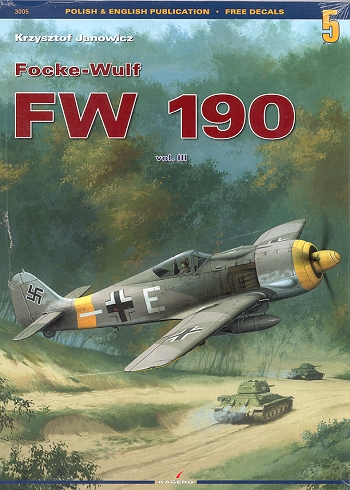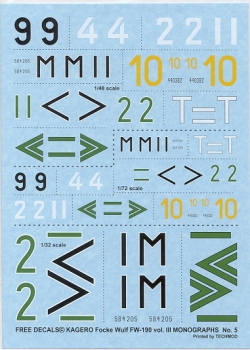 Continuing
with the story of the FW-190, this volume covers the fighter-bomber and a
few miscellaneous versions of the 190. Well written, it is in the usual
format of this series with Polish on the left side of the page and English
on the right. The verbiage flowed well and was easy to follow in the
English portion. It starts off in a most typical Kagero fashion with a
detailed description of a mission involving the subject aircraft. This is
then followed by a history of the type in a diary format. There are times
when this format becomes a bit numbing after a while, but the author does a
good job in keeping our interest.
Continuing
with the story of the FW-190, this volume covers the fighter-bomber and a
few miscellaneous versions of the 190. Well written, it is in the usual
format of this series with Polish on the left side of the page and English
on the right. The verbiage flowed well and was easy to follow in the
English portion. It starts off in a most typical Kagero fashion with a
detailed description of a mission involving the subject aircraft. This is
then followed by a history of the type in a diary format. There are times
when this format becomes a bit numbing after a while, but the author does a
good job in keeping our interest.
The use of the aircraft as a fighter bomber starts in 1942
with cross-channel attacks against British targets, which eventually
include night attack sorties. These night attacks are ruinously expensive
in terms of losses after initial success. In fact, I found it interesting
that in only two months of operation, the British were rewarded with four
complete aircraft as pilots had lost their bearings in the dark and landed
on English bases!
Things then move to operations in Algeria and then on to
Sicily and the Italian peninsula. Operations on the Eastern Front are also
well covered as this is probably where the 190 saw the greatest use as a 'jabo'.
In addition to its use in western Europe against Allies after the Normady
landings, it was also quite successful in use by maritime units to help
protect incoming and outgoing U-boats in the Bay of Biscay. One of its more
successful uses was as a 'Wilde Sau' night fighter, but increased daylight
bombing activity brought that to an end. Finally, the 190's use as the
command aircraft in Mistel operations is briefly covered.
 Where
the book has some deficiencies is in the choice of photos. Not that there
aren't any or that they are poorly done, but with a book on the jabo
version of the aircraft, there are precious few photos of the types. Mostly
what we find are factory photos of parts of 190A-0 preproduction prototypes
and images of standard fighters, interesting though they may be. There are
photos of the aircraft used in 'slipper wing' fuel tank experiments with
nothing in the write-up about it. No Mistel images are provided nor any
images of the 190 in North Africa or the planes involved in the early
intruder operations against England. This tells me that there is a real
need for the editor of the series to get involved and coordinate images
with the rest of the book.
Where
the book has some deficiencies is in the choice of photos. Not that there
aren't any or that they are poorly done, but with a book on the jabo
version of the aircraft, there are precious few photos of the types. Mostly
what we find are factory photos of parts of 190A-0 preproduction prototypes
and images of standard fighters, interesting though they may be. There are
photos of the aircraft used in 'slipper wing' fuel tank experiments with
nothing in the write-up about it. No Mistel images are provided nor any
images of the 190 in North Africa or the planes involved in the early
intruder operations against England. This tells me that there is a real
need for the editor of the series to get involved and coordinate images
with the rest of the book.
On the plus side, there are a number of nice color photos
of the aircraft restored by the Smithsonian Institution, there are 1/48
drawings of the two seat trainer (which isn't covered in this volume) and
various F-8 versions. Also in the book are separate 1/32 drawings for the
A-5 and the A-8 versions. The Techmod decals provided cover 8 different
aircraft and are limited to the unique markings (often just numbers) in
1/72 and 1/48 scale with three planes covered in 1/32. This is a fine way
to do the decals as we can easily use kit provided or aftermarket decals
for insignia and data markings.
Despite my concerns about the photos, this is a fine
historical overview of fighter-bomber operations. The superbly done
profiles, decals and drawings are a real asset and make this a book that I
can recommend to you.
You can find this book and many others at

If you would like your product reviewed fairly and quickly by a
site that has around 300,000 visitors a month, please contact
me or see other details in the Note to
Contributors.
 Continuing
with the story of the FW-190, this volume covers the fighter-bomber and a
few miscellaneous versions of the 190. Well written, it is in the usual
format of this series with Polish on the left side of the page and English
on the right. The verbiage flowed well and was easy to follow in the
English portion. It starts off in a most typical Kagero fashion with a
detailed description of a mission involving the subject aircraft. This is
then followed by a history of the type in a diary format. There are times
when this format becomes a bit numbing after a while, but the author does a
good job in keeping our interest.
Continuing
with the story of the FW-190, this volume covers the fighter-bomber and a
few miscellaneous versions of the 190. Well written, it is in the usual
format of this series with Polish on the left side of the page and English
on the right. The verbiage flowed well and was easy to follow in the
English portion. It starts off in a most typical Kagero fashion with a
detailed description of a mission involving the subject aircraft. This is
then followed by a history of the type in a diary format. There are times
when this format becomes a bit numbing after a while, but the author does a
good job in keeping our interest. Where
the book has some deficiencies is in the choice of photos. Not that there
aren't any or that they are poorly done, but with a book on the jabo
version of the aircraft, there are precious few photos of the types. Mostly
what we find are factory photos of parts of 190A-0 preproduction prototypes
and images of standard fighters, interesting though they may be. There are
photos of the aircraft used in 'slipper wing' fuel tank experiments with
nothing in the write-up about it. No Mistel images are provided nor any
images of the 190 in North Africa or the planes involved in the early
intruder operations against England. This tells me that there is a real
need for the editor of the series to get involved and coordinate images
with the rest of the book.
Where
the book has some deficiencies is in the choice of photos. Not that there
aren't any or that they are poorly done, but with a book on the jabo
version of the aircraft, there are precious few photos of the types. Mostly
what we find are factory photos of parts of 190A-0 preproduction prototypes
and images of standard fighters, interesting though they may be. There are
photos of the aircraft used in 'slipper wing' fuel tank experiments with
nothing in the write-up about it. No Mistel images are provided nor any
images of the 190 in North Africa or the planes involved in the early
intruder operations against England. This tells me that there is a real
need for the editor of the series to get involved and coordinate images
with the rest of the book. 